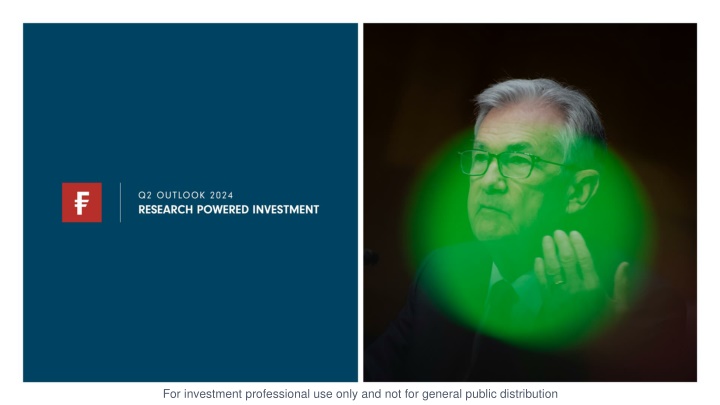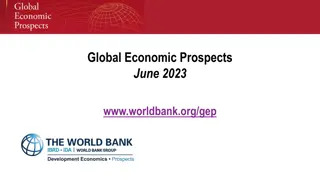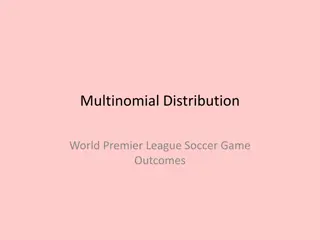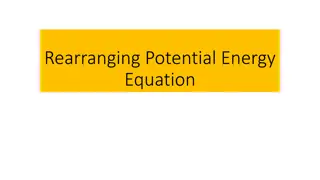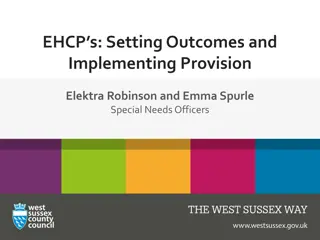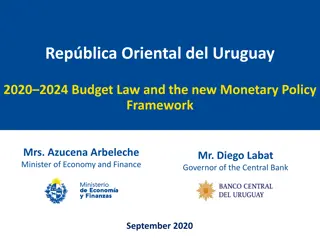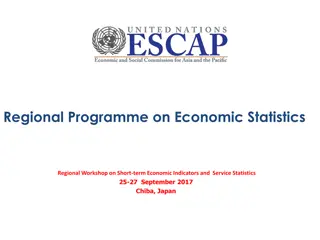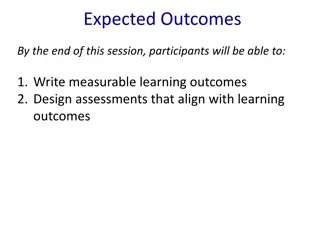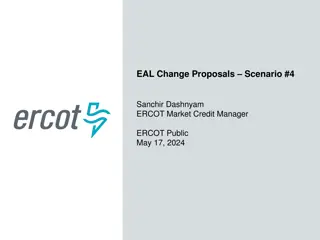Economic Scenarios and Potential Outcomes for 2024
The presented information outlines four scenarios for developed markets in 2024: Soft Landing, Cyclical Recession, No Landing, and Balance Sheet Recession. Each scenario discusses possible growth patterns, inflation rates, monetary and fiscal policy implications. Factors such as inflation stickiness, resilience in growth, deep recessions, and constrained stimulus are considered. Key themes include disinflation, monetary policy adjustments, and potential shifts in fiscal stances towards achieving target growth and inflation rates.
Uploaded on Oct 02, 2024 | 3 Views
Download Presentation

Please find below an Image/Link to download the presentation.
The content on the website is provided AS IS for your information and personal use only. It may not be sold, licensed, or shared on other websites without obtaining consent from the author.If you encounter any issues during the download, it is possible that the publisher has removed the file from their server.
You are allowed to download the files provided on this website for personal or commercial use, subject to the condition that they are used lawfully. All files are the property of their respective owners.
The content on the website is provided AS IS for your information and personal use only. It may not be sold, licensed, or shared on other websites without obtaining consent from the author.
E N D
Presentation Transcript
For investment professional use only and not for general public distribution
Four scenarios for developed markets in 2024 5%+ Scenario 1: Soft landing 40% Inflation Stagflation Scenario 2: Cyclical recession 4% 3 Inflation rate 25% 2 1 2% Scenario 3: No landing 30% Recession 4 Soft landing Reflation Scenario 4: Balance sheet recession <0% 5% <-2% 0% <1% 3% 4%+ Growth (GDP per annum) Note: Inflation rate measured by US Core Personal Consumption Expenditures Price Index. Growth by US GDP per annum. Source: Fidelity International, March 2024. Fidelity International Internal Information 2
How the scenarios could play out Growth Inflation Monetary policy Fiscal policy SLIGHTLY BELOW-TREND SLOWDOWN Growth in major economies settles at (or slightly below) trend BACK TO TARGET Disinflation brings core inflation back to target; no major additional shocks to headline rate BACK TO NEUTRAL Central banks start cutting rates, going back to historical levels of implied neutral rates Scenario 1: Soft landing NEUTRAL STANCE No major shift in fiscal stance 40% HIGHER FOR LONGER FOLLOWED BY A PIVOT Inflation stickiness forces central banks to remain behind the curve of macro damage. They only start to cut rates when the labour market has definitively cracked. Real policy rates fall RECESSION BRINGS INFLATION BACK TO TARGET Following a period of stickiness, core inflation falls back to target because of damage to the demand side of the economy Scenario 2: Cyclical recession MODERATE RECESSION DM economies go into contraction followed by recovery later in 2024/early 2025. Asynchronous timelines for different regions (EA/UK first, US later) NEUTRAL STANCE No major shift in fiscal stance 25% HIGHER FOR LONGER With resilient growth and Fed policy makers psychologically scarred by the 2021 experience, policy rates continue to be nudged up. Belated acceptance that neutral rate (R*) has risen NEUTRAL TO MILDLY RESTRICTIVE Divided government in Washington takes additional stimulus off the table GOP control of Congress would inject a slow negative drag. In Europe, peripheral economies forced to retrench given negative debt dynamics ABOVE TARGET STICKY INFLATION Following initial disinflation, core inflation remains sticky, settling 1-2 percentage points above central bank targets Scenario 3: No landing CONTINUED RESILIENCE Resilience in US growth continues and Europe s current slowdown reverses 30% DEEP RECESSION DM and some EM economies see deep and prolonged recessions lasting through to year-end as serious default cycles take hold in corporates with vulnerable sovereigns also under pressure SHARP PIVOTS FROM KEY CENTRAL BANKS Central banks keep rates higher for too long and pivot too late. Lumpy transmission of monetary policy inadvertently triggers deleveraging Scenario 4: Balance sheet recession CONSTRAINED STIMULUS Fiscal policy kicks in when growth outcomes become very painful, although monetary policy will still be the main backstop REVERSAL OF INFLATIONARY TRENDS Inflation reverses as debt deleveraging takes hold 5% Source: Fidelity International, March 2024. Fidelity International Internal Information 3
The base case why were expecting a soft landing Falling inflation marks the end of the rate hiking cycle, providing a supportive environment for risk assets 10% 6% 5% 8% 4% 6% 3% 4% 2% 2% 1% 0% 0% Jan-17 Jan-18 Jan-19 Jan-20 Jan-21 Jan-22 Jan-23 Jan-24 Jan-25 US CPI y/y (LHS) Fed Funds Rate (RHS) Source: Bloomberg, Haver Analytics, February 2024. *Dotted lines shows market implied Fed Funds Target Rates. Fidelity International Internal Information 4
Our analysts have recorded improving sentiment since the turn of the year, though costs remain sticky 1.00 1.20 1.00 0.80 Weighted average of responses 0.80 0.60 Costs increasing 0.60 0.40 0.40 0.20 0.20 0.00 0.00 -0.20 Costs decreasing -0.20 -0.40 -0.40 -0.60 May-21 May-22 May-23 Jul-20 Mar-21 Jul-21 Mar-22 Jul-22 Mar-23 Jul-23 Mar-24 Sep-20 Nov-20 Sep-21 Nov-21 Sep-22 Nov-22 Sep-23 Nov-23 Jan-21 Jan-22 Jan-23 Jan-24 Apr-20 Apr-21 Apr-22 Apr-23 Oct-20 Oct-21 Oct-22 Oct-23 Feb-21 Feb-22 Feb-23 Feb-24 Aug-20 Dec-20 Aug-21 Dec-21 Aug-22 Dec-22 Aug-23 Dec-23 Jun-20 Jun-21 Jun-22 Jun-23 Leading indicators Management sentiment Total labour costs Total non-labour costs Chart shows proportion of responses reporting costs are increasing minus those reporting costs are decreasing; significant increases and significant decreases receive a higher weighting. Questions: What are your expectations for total labour costs over the next 6 months compared to current levels? , and What are your expectations for total non- labour costs over the next 6 months compared to current levels? Source: Fidelity International, March 2024. Chart shows proportion of responses reporting management sentiment is positive minus those reporting management sentiment is negative; likewise leading indicators. Strong negative and strong positive receive a higher weighting. Questions: Based on your recent research and interactions with companies, to what extent, if at all, has your perception of management sentiment over the next 6 months changed? , and What is the outlook for leading indicators over the next 6 months at your companies? Source: Fidelity International, March 2024. Fidelity International Internal Information 5
But beware - no landing is looking more likely, especially in the US US remains an outlier with high and rising growth and inflation expectations a tricky combination for the Fed to manage 2024 GDP Bloomberg consensus forecast 2024 CPI Bloomberg consensus forecast 2.5 5.2 3.5 5.0 3.0 2.0 4.8 2.5 1.5 %YoY %YoY %YoY 4.6 2.0 1.0 4.4 1.5 0.5 4.2 1.0 0.0 Mar-22 4.0 0.5 Mar-22 Jul-22 Nov-22 Mar-23 Jul-23 Nov-23 Mar-24 Jul-22 Nov-22 Mar-23 Jul-23 Nov-23 Mar-24 US EA Japan UK China (RHS) US EA Japan UK China Source: Fidelity International, Bloomberg, March 2024. Source: Fidelity International, Bloomberg, March 2024. Fidelity International Internal Information 6
Three scenarios for China in 2024 Growth Inflation Monetary policy Fiscal policy The pace of recovery gradually gains momentum as consumption continues to lead. External demand slows moderately but downside pressures will be partially offset by a recovery in domestic demand. Growth stabilises in line with the government s growth target. Scenario 1: Controlled stabilisation Incremental easing to coordinate with fiscal stimulus, the PBoC gradually lowers both benchmark rates and the reserve requirement ratio to lower financing costs and provide ample liquidity support. CPI and PPI rebound initially on the back of a recovery in domestic demand. Inflation stabilises slightly below target over the medium term. Policymakers roll out proactive easing and de-risking plans to resolve structural issues in local government, property and banking sectors. 65% Scenario 2: Serious slowdown The economy faces stronger headwinds from domestic structural issues and a developed market slowdown. If financial market stress spreads, private and consumer confidence could be slow to return and growth would remain well below potential. Policymakers are slow to introduce sufficient fiscal support for growth. Both CPI and PPI gradually fall into deflation well below government targets. Easing is in small steps and with limited effect. 25% The recovery becomes more broad- based and gains momentum with a more dovish policy setting. Property sector takes the lead from a strong monetary policy push. The initial impulse is strong, but it creates more debt problems in future. Growth may rebound above target. Scenario 3: Reflation The PBoC eases monetary policy more aggressively with consecutive benchmark rate and reserve requirement ratio cuts. The system is flushed with liquidity to accommodate broad-based re-leveraging. Both CPI and PPI recover and gain momentum with the strong domestic demand rebounding to match or beat the government target. Policymakers explicitly bail out stressed local governments and property sector companies, leading to renewed optimism in re-leveraging. 10% Source: Fidelity International, March 2024. Fidelity International Internal Information 7
Services sector continues to note above average growth with manufacturing recovering to trend growth levels. The property sector remains a drag China activity indicator (CH-AI) by sector 4 3 2 1 Z-Score 0 -1 -2 -3 -4 Jun 07 Dec 08 Jun 10 Dec 11 Jun 13 Dec 14 Jun 16 Dec 17 Jun 19 Dec 20 Jun 22 Dec 23 Industry Services Property Note: The latest update is as of December 2023 as official data for January and February combined is due in mid-March. Source: Fidelity International, FIL Global Macro Team calculations, Bloomberg, Haver Analytics, Wind, March 2024. Fidelity International Internal Information 8
Multi Asset: Our Best Ideas Tilting towards Value Structural Themes Defence Carry Alternatives Scenario 1: Soft landing ++ EM LC bonds ++ Hybrids + Credit + Liquid Alts + REITs + Commodities ++ Global Mid Caps ++ Select EM equities (China, Greece, Indonesia, S Korea) ++ AI/Semiconductors ++ Biotech/Healthcare ++ Climate Solutions + Min Vol Equities 40% Scenario 2: Cyclical recession ++ Absolute Return ++Dispersion + Gold ++ Put Options + Government Bonds ++ USDCash ++ Short Duration Credit -- High Yield Bonds + Healthcare + Climate Solutions -- US Small-Caps 25% -- Equities + Global Mid Caps + Japanese Equities FX hedged + Cyclical equities Scenario 3: No landing + Dividend Futures ++ Hybrids - Investment Grade + Future Financials + Transition Materials ++ Absolute Returns --Bond proxies - Government Bonds 30% --US Mega-Caps / Growth / Momentum Scenario 4: Balance sheet recession -- US Small-Caps -- US Mega-Caps / Growth / Momentum ++ Put Options ++ Government Bonds ++ USDCash ++ Short Duration Credit -- High Yield Bonds + Absolute Returns + Dispersion 5% -- Equities Notes: + is a positive view; - is negative; reflects our views of relative performance for each scenario. Source: Fidelity International, March 2024 Fidelity International Internal Information 9
Important Information This document is for Investment Professionals only and should not be relied on by private investors. This document is provided for information purposes only and is intended only for the person or entity to which it is sent. It must not be reproduced or circulated to any other party without prior permission of Fidelity. This document does not constitute a distribution, an offer or solicitation to engage the investment management services of Fidelity, or an offer to buy or sell or the solicitation of any offer to buy or sell any securities in any jurisdiction or country where such distribution or offer is not authorised or would be contrary to local laws or regulations. Fidelity makes no representations that the contents are appropriate for use in all locations or that the transactions or services discussed are available or appropriate for sale or use in all jurisdictions or countries or by all investors or counterparties. This communication is not directed at, and must not be acted on by persons inside the United States and is otherwise only directed at persons residing in jurisdictions where the relevant funds are authorised for distribution or where no such authorisation is required. Fidelity is not authorised to manage or distribute investment funds or products in, or to provide investment management or advisory services to persons resident in, mainland China. All persons and entities accessing the information do so on their own initiative and are responsible for compliance with applicable local laws and regulations and should consult their professional advisers. Reference in this document to specific securities should not be interpreted as a recommendation to buy or sell these securities, but is included for the purposes of illustration only. Investors should also note that the views expressed may no longer be current and may have already been acted upon by Fidelity. The research and analysis used in this documentation is gathered by Fidelity for its use as an investment manager and may have already been acted upon for its own purposes. This material was created by Fidelity International. Past performance is not a reliable indicator of future results. This document may contain materials from third-parties which are supplied by companies that are not affiliated with any Fidelity entity (Third-Party Content). Fidelity has not been involved in the preparation, adoption or editing of such third-party materials and does not explicitly or implicitly endorse or approve such content. Fidelity International refers to the group of companies which form the global investment management organization that provides products and services in designated jurisdictions outside of North America Fidelity, Fidelity International, the Fidelity International logo and F symbol are trademarks of FIL Limited. Fidelity only offers information on products and services and does not provide investment advice based on individual circumstances. Issued in Europe: Issued by FIL Investments International (FCA registered number 122170) a firm authorised and regulated by the Financial Conduct Authority, FIL (Luxembourg) S.A., authorised and supervised by the CSSF (Commission de Surveillance du Secteur Financier) and FIL Investment Switzerland AG. For German wholesale clients issued by FIL Investment Services GmbH, Kastanienh he 1, 61476 Kronberg im Taunus. For German institutional clients issued by FIL (Luxembourg) S.A., 2a, rue Albert Borschette BP 2174 L- 1021 Luxembourg. Zweigniederlassung Deutschland: FIL (Luxembourg) S.A. - Germany Branch, Kastanienh he 1, 61476 Kronberg im Taunus. In Hong Kong, this document is issued by FIL Investment Management (Hong Kong) Limited and it has not been reviewed by the Securities and Future Commission. FIL Investment Management (Singapore) Limited (Co. Reg. No: 199006300E) is the legal representative of Fidelity International in Singapore. FIL Asset Management (Korea) Limited is the legal representative of Fidelity International in Korea. In Taiwan, Independently operated by FIL Securities (Taiwan ) Limited, 11F, 68 Zhongxiao East Road., Section 5, Xinyi Dist., Taipei City, Taiwan 11065, R.O.C Customer Service Number: 0800-00-9911#2 Issued in Australia by Fidelity Responsible Entity (Australia) Limited ABN 33 148 059 009, AFSL No. 409340 ( Fidelity Australia ). This material has not been prepared specifically for Australian investors and may contain information which is not prepared in accordance with Australian law. ED24-059 Fidelity International Internal Information 10
